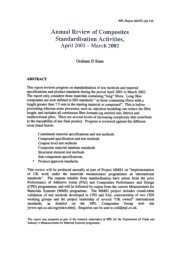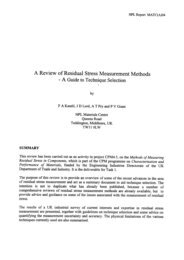Dimensional Measurement using Vision Systems - NPL Publications ...
Dimensional Measurement using Vision Systems - NPL Publications ...
Dimensional Measurement using Vision Systems - NPL Publications ...
You also want an ePaper? Increase the reach of your titles
YUMPU automatically turns print PDFs into web optimized ePapers that Google loves.
<strong>Measurement</strong> Good Practice Guide No. 39<br />
The limit of magnification by visual optical microscopy has now almost been reached.<br />
From equation (1) it will be seen that decreasing the illumination wavelength λ can reduce<br />
the minimum object separation resolvable by a microscope objective. However, in terms of<br />
optical microscopy the minimum useful wavelength is around 300 nm in the ultraviolet<br />
(UV) region of the spectrum and this only produces a resolution improvement of around<br />
x2. It also brings with it the added complexity that specially designed optics have to be<br />
employed in the UV.<br />
A more significant improvement can be achieved by <strong>using</strong> a scanning electron microscope.<br />
Although the numerical apertures of electron lenses are very limited, the effective<br />
wavelength of the electron beam is extremely small and a resolution limit of 10 nm<br />
(0.01 µm) or even less is readily achievable, a figure at least thirty times smaller than<br />
achievable with an optical microscope. Thus, in the future, with the ever-decreasing size of<br />
microelectronic structures, the use of electron microscopy will inevitably become more<br />
widespread.<br />
2.2 ABERRATIONS IN THE IMAGE FORMING SYSTEM<br />
The intensity distribution in the Airy pattern shown in Figure 2 will only be produced by a<br />
lens of perfect quality. In practice, defects in the lens performance will result in some<br />
redistribution of the energy, usually leading to degradation in image quality and to errors<br />
if the system is employed for making dimensional measurements. These defects are<br />
known as aberrations and can be divided into the following types.<br />
2.2.1 Spherical aberration<br />
If, after passing through different parts of the lens aperture, the rays of light from a single<br />
object point are focused in different image planes, the lens is said to exhibit spherical<br />
aberration (see Figure 4). With increasing spherical aberration in a lens, the intensity of the<br />
central disc of the diffraction pattern gradually decreases, accompanied by more light in<br />
the surrounding rings. This results in reduced image contrast and resolution. Although<br />
microscope objectives are usually well corrected for spherical aberration, some may easily<br />
be introduced by <strong>using</strong> incorrect working conditions e.g. the wrong tube length (see<br />
Section 2.4.6).<br />
7
















